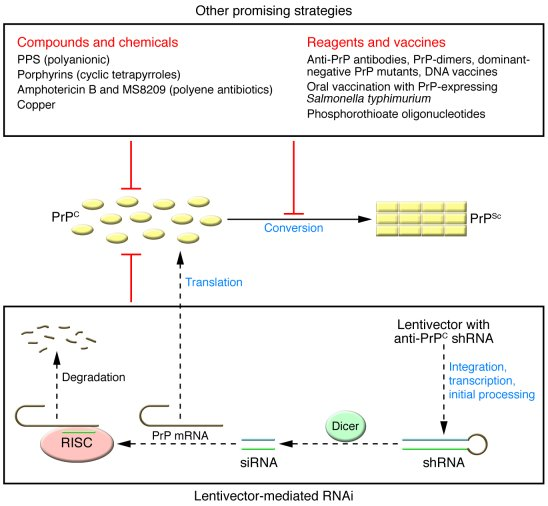Prion disease treatment is at the forefront of innovative biomedical research, offering a glimmer of hope for patients suffering from these horrifically fatal disorders, including Creutzfeldt-Jakob disease and fatal familial insomnia. Recent breakthroughs in gene-editing therapy, particularly using base editing technology, have shown promising results in laboratory studies, which effectively reduced harmful protein levels by 50% in animal models. This pioneering lab research on prion disease, spearheaded by renowned scientists, could pave the way for human trials and potential therapies tailored to combat these degenerative conditions. The collaborative efforts of the research community, combined with the personal motivations of those affected by prion diseases, underscore the urgency of developing effective treatments. As we navigate this complex field of study, the possibility of altering the course of prion diseases through genetic interventions is not just a dream—it’s becoming a tangible reality.
The treatment of prion diseases—often described as devastating neurodegenerative disorders—aims to tackle the dire consequences of misfolded proteins in the brain. Conditions like Creutzfeldt-Jakob disease and its hereditary variant, fatal familial insomnia, have posed significant challenges to researchers and healthcare providers alike. However, advancements in gene-editing methodologies such as base editing are proving to be essential tools in the fight against these lethal illnesses. With each stride in lab research on prion diseases, the scientific community grows closer to pioneering treatment options that could transform the lives of patients. The ongoing exploration of genetic therapies marks a new chapter in neurodegenerative disease treatment, highlighting the critical intersection of patient experience and scientific discovery.
Introduction to Prion Disease and Its Impact
Prion diseases are a group of rare neurological disorders characterized by the misfolding of proteins, leading to progressive brain damage. Among the most notable conditions within this group are Creutzfeldt-Jakob disease and fatal familial insomnia. These diseases have devastating effects on patients, often resulting in severe cognitive decline and ultimately death. The mystery surrounding their origin—whether sporadic or genetic—only compounds the urgency for effective treatments. Moreover, these disorders affect not only the patients but also their families, underlining the critical need for advancements in research that could lead to innovative therapies.
Recent advancements in understanding prion diseases have opened the door to potential therapeutic strategies. The involvement of patient-scientists, like Sonia Vallabh, adds a deeply personal dimension to this research, creating a unique drive to find treatments. As researchers work through various methodologies, their findings indicate a hopeful trajectory toward a future where prion diseases may no longer be considered terminal.
Frequently Asked Questions
What are the latest advancements in prion disease treatment using gene-editing therapy?
Recent advancements in prion disease treatment include the development of a promising gene-editing therapy that utilizes base editing technology. Researchers have demonstrated that altering a single base in the gene responsible for producing harmful proteins can significantly reduce their presence in laboratory mice, potentially extending their lifespan. This research marks a significant step toward effective treatments for conditions like Creutzfeldt-Jakob disease and fatal familial insomnia.
How does base editing technology enhance the treatment of prion diseases?
Base editing technology enhances the treatment of prion diseases by allowing precise changes at the genetic level. In the context of prion disease treatment, researchers have found that modifying a specific base in the prion protein gene decreases the production of toxic proteins by 63% in laboratory models, suggesting a potential pathway for intervention in conditions like Creutzfeldt-Jakob disease and fatal familial insomnia.
What role does lab research play in developing prion disease treatments?
Lab research plays a crucial role in developing prion disease treatments by advancing our understanding of the genetic underpinnings of these disorders. Researchers utilize animal models to study the effects of gene-editing therapy on prion diseases, such as Creutzfeldt-Jakob disease. This foundational research is essential for developing safe and effective treatments for these fatal conditions.
Can gene-editing therapy provide a cure for fatal familial insomnia?
While gene-editing therapy shows great promise in reducing symptoms and extending lifespan in models of prion diseases, it is important to note that human trials are still several years away. Fatal familial insomnia may benefit from such treatments, as researchers are actively studying the potential of gene-editing techniques to alter the genetic causes of this and other prion diseases.
What is the significance of patient-scientists in prion disease treatment research?
Patient-scientists, like Sonia Vallabh and Eric Minikel, bring a unique and personal perspective to prion disease treatment research. Their direct connection to conditions such as fatal familial insomnia fuels their motivation to discover effective therapies. This collaboration between scientific inquiry and personal experience enhances the efforts to develop innovative treatments utilizing gene-editing technology and other advanced methodologies.
| Key Points | Details |
|---|---|
| Overview | Research into prion disease treatment shows promise through gene-editing techniques. |
| Research Publication | Findings published in Nature Medicine demonstrate a 50% reduction of harmful proteins in mice’s brains. |
| Milestone Achieved | Significant progress towards potential clinical trials after 9 years of research. |
| Patient-Scientist Dynamics | Collaboration driven by personal experiences of researchers affected by prion disease. |
| Technique Used | Single base editing method reduces prion protein production in mice. |
| Future Steps | Refining techniques and preparing for eventual human trials over the coming years. |
Summary
Prion disease treatment is progressing through innovative gene-editing research, signaling a potential breakthrough in combating these fatal disorders. The collaborative efforts of patient-scientists like Sonia Vallabh and Eric Minikel exemplify the personal commitment that drives this research forward. As the scientific community continues to navigate the complexities and necessary steps toward clinical trials, the recent findings offer a glimmer of hope for those affected by prion diseases.
